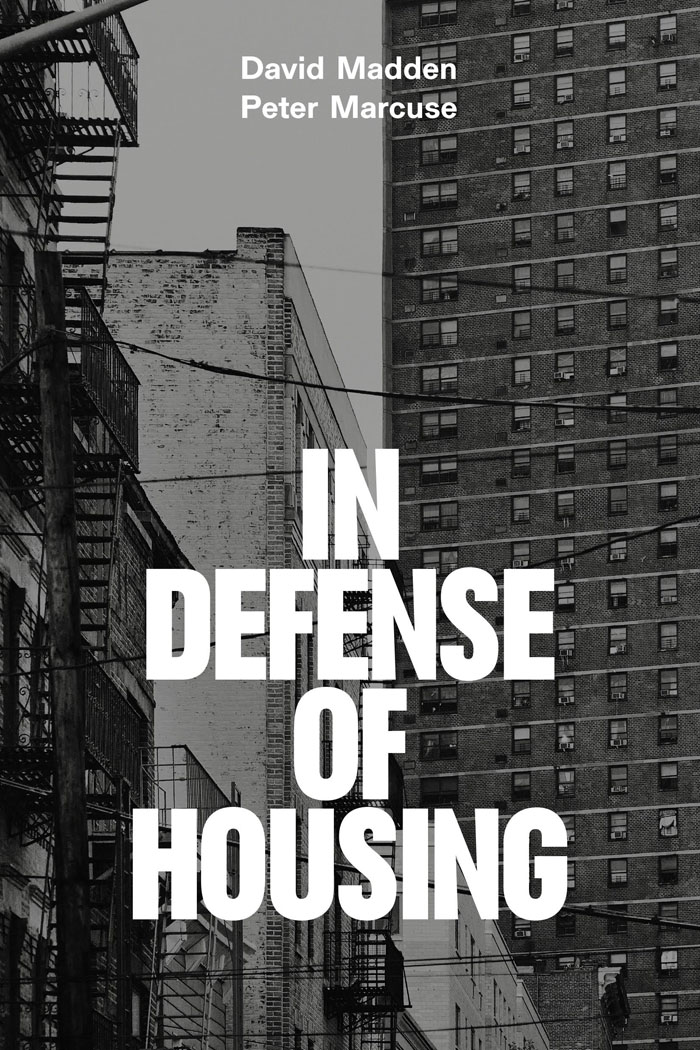tales of housing in America
 Lisa Goff’s cultural history of the shanty (Shantytown, USA Cambridge, MA: Harvard
University Press, 2016) and David Madden & Peter Marcuse’s broadside
against the system that produces (and reproduces) housing scarcity (In Defense of Housing New York: Verso, 2016) are both attempts to look at just what it takes to have a roof over your head
in America.
Lisa Goff’s cultural history of the shanty (Shantytown, USA Cambridge, MA: Harvard
University Press, 2016) and David Madden & Peter Marcuse’s broadside
against the system that produces (and reproduces) housing scarcity (In Defense of Housing New York: Verso, 2016) are both attempts to look at just what it takes to have a roof over your head
in America.
Goff writes to rescue the shanty from ignominy, showing that
the ten-by-ten wood hut was an ingenious indigenous part of the development
of America. Madden & Marcuse write to rescue the “lived,
universally-necessary, social dimension” of housing from its modern incarnation
as real estate.
But when you look at housing in this way, you miss all the
specifics. Goff’s shantytowns. Modern trailer parks (home to 20 million people, 6% of the U.S. population) and tent communities. The laws
many cities have passed to criminalize homelessness. The absurdity that the right to an attorney doesn’t exist in housing court – which means tenants can be evicted without ever having even spoken
with a lawyer. The databases that landlords maintain on renters who have simply tried to exercise their rights.
And here’s the most serious failing of a book that seems laser-focused
on cities like New York in the 21st century: there is not even a single
mention of Airbnb. Whatever you think of Airbnb – personally, I have serious
problems with it, but several friends have movingly described their belief that
Airbnb rentals have enabled African-American and Caribbean homeowners to manage
the massive property tax increases that come in fast-gentrifying neighborhoods –
this is no small omission: in this undated report, the short-stay company says over the course of a year 416,000 renters used airbnb to visit the 5 boroughs of New York, each of them staying an average of almost a week.With Airbnb, home isn’t where the heart is, it’s where the money is, too. Your home is no longer simply the
place you live. It takes on a second role as a personal profit center. Airbnb transforms
tenants into landlords and your home into an economic value. There’s little question that the short term rental market is part of what
M&M condemn as the “commodification” of housing.
At the same time, M&M largely let large landlords off the hook. “We cannot blame real estate companies for today’s housing injustices,” they aver. “As entities created, using the legal powers of the state, for the sole purpose of economic accumulation, corporations are single-minded by design. Profit seeking without regard for external social consequences is intrinsic to the way they are set up.”
At the same time, M&M largely let large landlords off the hook. “We cannot blame real estate companies for today’s housing injustices,” they aver. “As entities created, using the legal powers of the state, for the sole purpose of economic accumulation, corporations are single-minded by design. Profit seeking without regard for external social consequences is intrinsic to the way they are set up.”
M&M’s big idea is that we must fight the “structural
logic” that perpetuates this unfair system. Sadly, as a former organizer (and also
as someone whose landlord hauled him to court to try to evict him), I know that you
have to fight for your home while you learn how to fight for systemic change.
You have to see the system in operation before you can believe it is as bad as
it is or figure out ideas to change it.
Marcuse has a long and inspiring history as a planner and activist in New
York. Madden, a sociologist at the London School of Economics, is also deeply embedded
in NYC. I really wanted to like their book -- and, indeed there are many wise things in it. But they seem alarmingly out of touch with the situation on the ground. “If
the inhabitants of New York have learned anything about their dwelling space,
it is that they must always be ready to defend it,” they write.
My
experience is the exact opposite. While most New Yorkers once knew about rent regulations and were willing to ask for things like housing code inspections, today, the majority seem to have no understanding of how
the system works. And they often hesitate to even complain for
fear of retribution or worry that they might wind up on a landlord shit list, which
essentially means that they’ll never be able to rent an apartment in this town again.
If
M&M had immersed themselves in the new urban reality, they would have
discovered that it’s a shit-storm out here. It mimics what Kate Tempest has written about contemporary
London:
The squats we used to party in
are
flats we can’t afford
The dumps we did our dancing in
have all
been restored
…
And so I’m moving on. I’ve got
it all to play for.
I’ll be the invader
in some
other neighbourhood
I’ll be sipping Perfect Coffee
thinking,
this is pretty good,
While the locals grit their
teeth and hum
Another
Fucking One Has Come.
--Let them Eat Chaos, New York: Bloomsbury, 2017, 52 & 55-56
So what do we do in this dog-eat-dog world, where a tenant
pushed out of one place becomes the one doing the pushing in the next and
rationalizes it as the way of the world? M&M have no answer.
Goff makes a compelling case that for many years, shanties
were one of the most common styles of homes in America. And she isn’t afraid of
the complexity involved in this realization. For instance, she notes, a change
in vocabulary pushed by some of the nation’s great housing reformers in the
1930s recast shanties as eternally blighted slums that propagated social pathologies.
“Once shantytowns were declared permanent slums, however, they were vulnerable
not only to residential or infrastructure development but to the large-scale
clearance that eventually became known as urban renewal.”
In In Defense of
Housing, M&M argue for more of that urban renewal (one of their rallying cries is “expand,
defend, and improve public housing.”) They also call for reversing the process
of deregulation and privatization, giving residents priority over owners (and,
by implication, people priority over profits), supporting
alternative ownership and management structures, and creating a united front so
that housing can be seen as one plank in the struggle for social justice. “A
radical right to housing raises our sights and sees the objective of action
more comprehensively, tying together in a common quest broader claims to
equality, dignity, solidarity, and welfare.”
Sounds great. But here’s the rub. If we follow their arguments to the
end, we wind up back with Engels in 1872: “The housing shortage is no accident.
It is a necessary institution and it can be abolished together with all its
effects on health, etc., only if the whole social order from which it springs
is fundamentally refashioned.”
One hundred and forty-five years on, we still can’t agree what
that refashioning of economic and social relations should look like. And while
I like their posh post-po-mo phrase, M&M’s “contradictory, non-reformist reformism” is not
likely to draw all that many people to the cause.
In the meantime, the structural logic being pushed in America right
now seems to be a retreat to social Darwinism rather than an endorsement of social justice. Which means that shantytowns -- their history, how to build them, and how to fight to keep them from being demolished -- may be much more
relevant than any of us have realized.





No comments:
Post a Comment